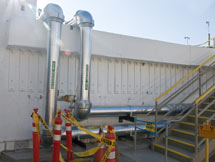
Handy Links
SLAC News Center
SLAC Today
- Subscribe
- Archives: Feb 2006-May 20, 2011
- Archives: May 23, 2011 and later
- Submit Feedback or Story Ideas
- About SLAC Today
SLAC News
Lab News
- Interactions
- Lightsources.org
- ILC NewsLine
- Int'l Science Grid This Week
- Fermilab Today
- Berkeley Lab News
- @brookhaven TODAY
- DOE Pulse
- CERN Courier
- DESY inForm
- US / LHC
SLAC Links
- Emergency
- Safety
- Policy Repository
- Site Entry Form

- Site Maps
- M & O Review
- Computing Status & Calendar
- SLAC Colloquium
- SLACspeak
- SLACspace
- SLAC Logo
- Café Menu
- Flea Market
- Web E-mail
- Marguerite Shuttle
- Discount Commuter Passes
-
Award Reporting Form
- SPIRES
- SciDoc
- Activity Groups
- Library
Stanford
Around the Bay
SSRL Reaches Seismic Upgrade Milestone
Structures at the Stanford Synchrotron Radiation Lightsource are bolstered against earthquakes, thanks to some hard work and funding from the American Recovery and Reinvestment Act. The work completes the first of two phases in the Recovery Act funded seismic upgrades at SSRL, which is located at the Department of Energy's SLAC National Accelerator Laboratory. Phase I, the Booster to SPEAR Seismic Retrofit Project, was completed on schedule on October 5, during SSRL's scheduled annual shutdown.
"The on-time completion is very helpful for us to get the accelerator up and running on schedule, and the new shielding looks great," said John Schmerge, the head of the SPEAR Accelerator Division at SSRL. The project created a solid foundation for shielding walls that previously rested on asphalt, replaced removable shielding blocks with a two-foot-thick, cast-in-place shielding wall, and replaced all the roof blocks in this area with new precast concrete roof blocks. Additional work consisted of anchoring the shielding walls to the new foundation and modifying the chilled water pipes. Even catwalk handrails and stairways were improved during the retrofit.
More improvements lie in store for next year's shutdown. A total of $3M in Recovery Act funding has been allotted to SLAC for SSRL seismic retrofits. Phase II of the project will include upgrades to the booster in addition to strengthening the injector building and Beamline 4.
Project Manager Larry Cadapan is an old hand at seismic retrofits at SSRL, having previously worked on such projects as upgrades to the main SSRL building, booster ring and the Beamline 12 alcove. For the most recent efforts, he pointed out that much important work was done even before contractors arrived to replace roof blocks and pour foundations. For example, in preparation for replacement of the roof, fixtures had to be removed and systems temporarily shut down. SSRL technicians got to work as soon as the beam was turned off for the annual SSRL shutdown.
"Temporary modifications had to be made to the personnel protection system, the fire protection system, lighting, conduits and cable trays, so the contractor could remove the old roof," Cadapan said. Additionally, SSRL technicians secured the accelerator itself. Once contractors installed 22 new roof blocks—varying in weight from about 22,000 pounds to the heaviest at 54,000 pounds—Cadapan's crew reinstalled all of the fixtures and systems.
Work planning and control efforts, including daily Job Safety Analyses and progress review meetings with the contractor, kept the project on track, even with 20 workers at the construction site. "Those were the busiest times," Cadapan said.
Cadapan acknowledged that the project was challenging, but said two key goals kept him focused: "Do the work safely, and finish on time."
—Lori Ann White
SLAC Today, October 25, 2010
